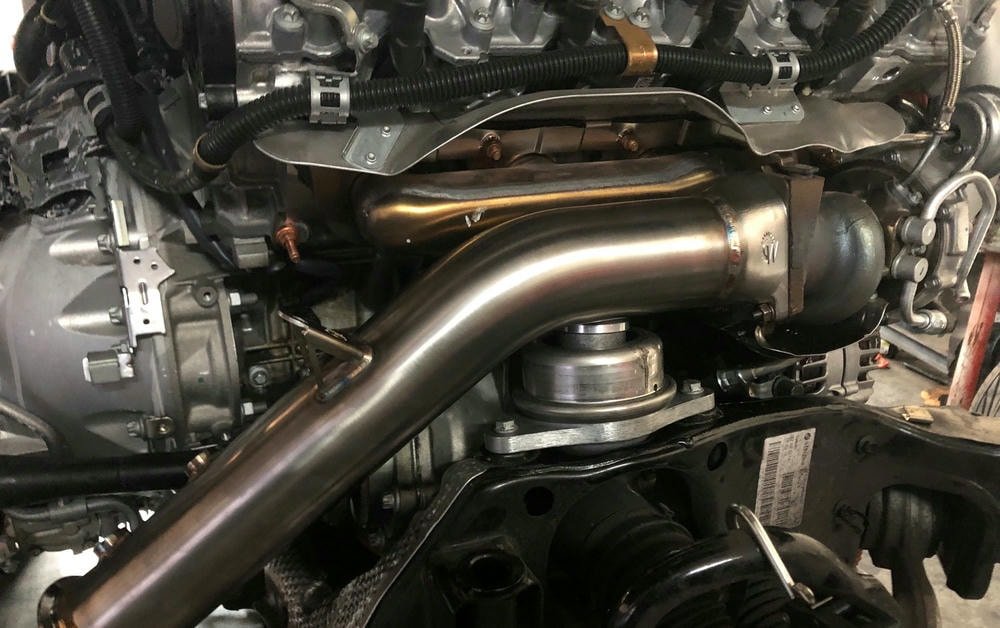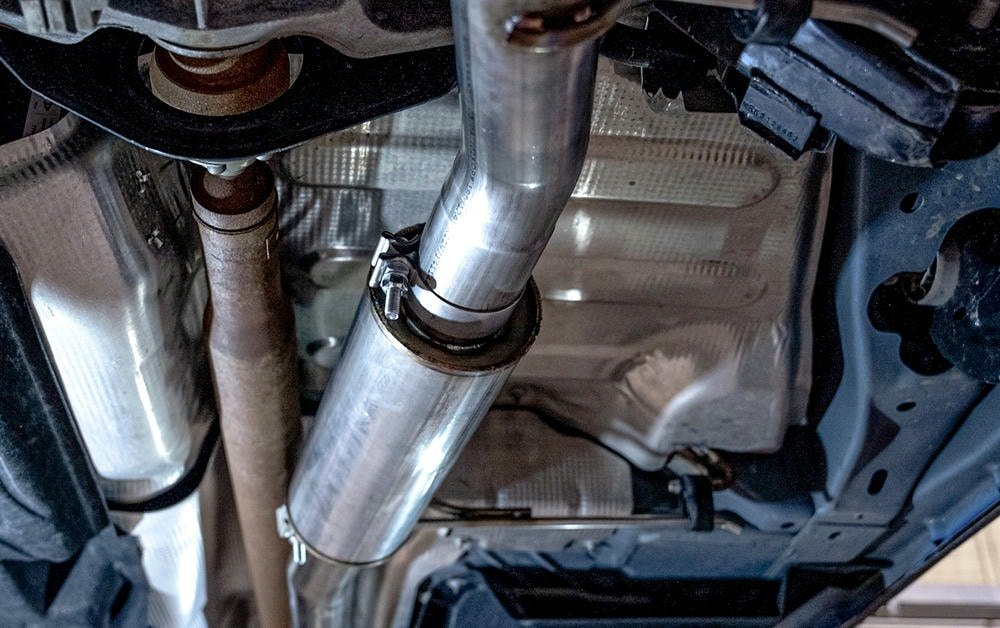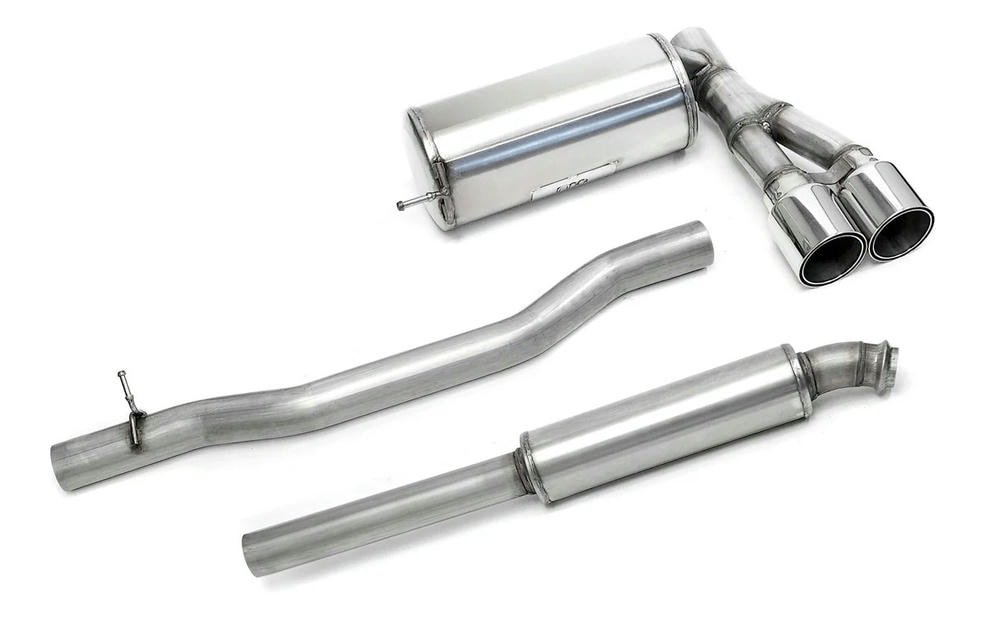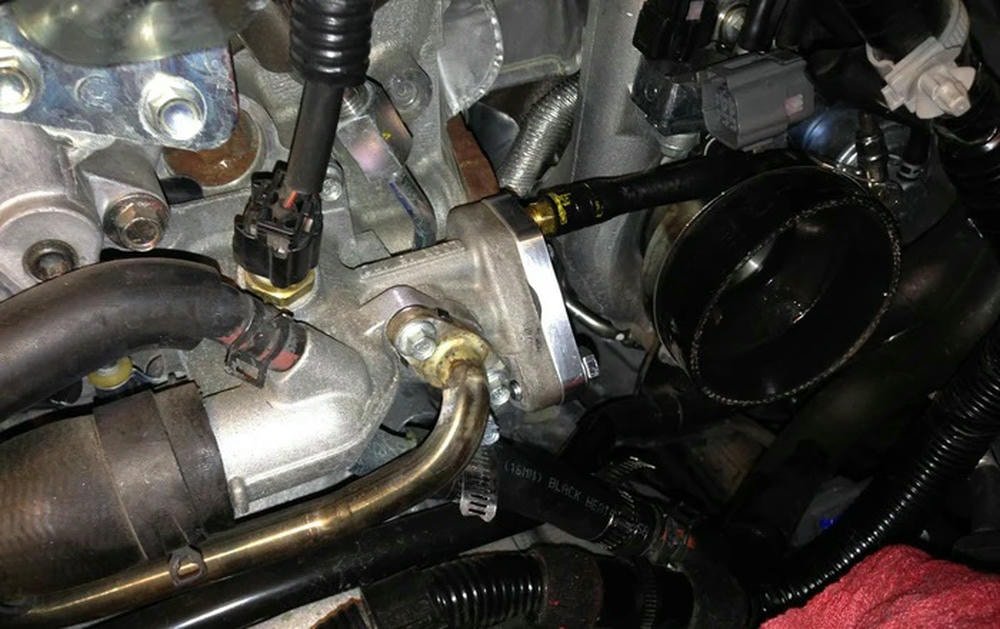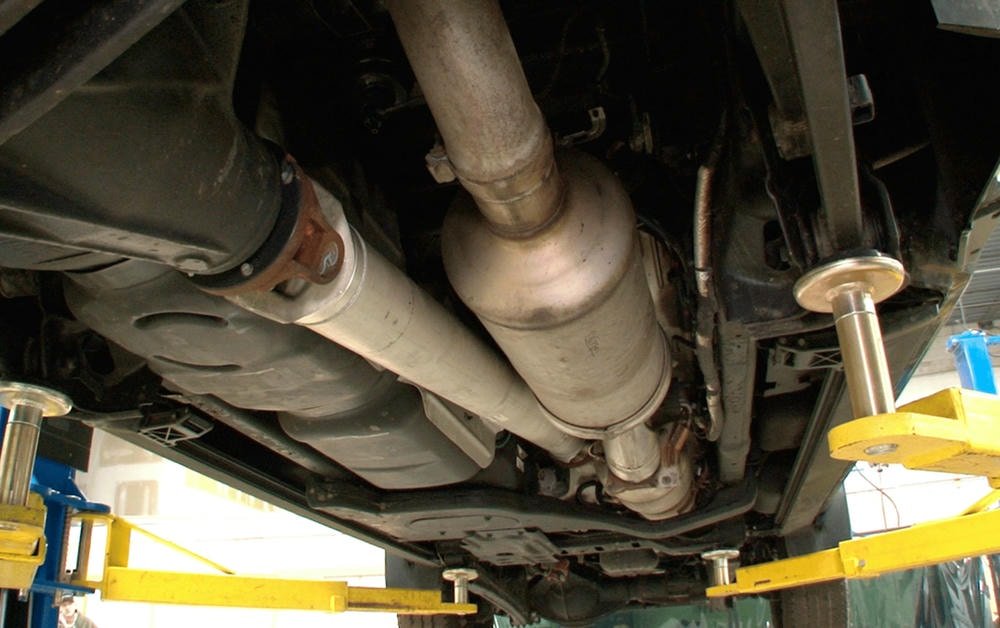Installing a turbo downpipe in a diesel truck is a detailed task that involves careful preparation and precise steps. A turbo downpipe connects the turbocharger to the exhaust system, playing a key role in vehicle performance.
This process requires specific tools like wrenches and screwdrivers, along with safety gear to protect oneself. Lifting the truck properly and removing the old downpipe are essential first steps before placing the new one.
After installation, checking all connections for leaks ensures everything is set up correctly. Testing how well the turbo and exhaust systems perform after this change tells if there were improvements.
If issues pop up, rechecking connections or adjusting parts may fix them. For diesel truck owners looking to boost their vehicle’s efficiency, understanding how to install a turbo downpipe rightly matters greatly.
Keep reading to learn more about each step in detail.
Table of Contents
TogglePreparation for Installation
Getting ready to install a turbo downpipe starts with gathering the right tools and making sure you stay safe. You need wrenches, screwdrivers, and safety gear like gloves and goggles.
Setting up the truck properly is also key to make sure everything goes smoothly.
Required Tools and Equipment
Installing a turbo downpipe on your diesel truck improves exhaust flow and boosts performance. The procedure necessitates the use of appropriate tools and a comprehensive method. Here is your essential tool checklist:
- Socket set: This set contains various sizes of sockets for both loosening and tightening bolts, specifically in the confined spaces around the exhaust manifold and downpipe.
- Wrench set: An assortment of wrenches aids in manipulating nuts and bolts that are out of reach for sockets.
- Screwdrivers: Useful for detaching or adjusting any clamps or components connected to the downpipe.
- Jack and jack stands: These tools are crucial for safely raising the truck to work underneath it. For safety reasons, using solid stands is essential.
- Gloves: Top-tier gloves safeguard your hands from sharp objects, heated parts, and dirt.
- Safety glasses: This protective gear defends your eyes from debris, especially beneficial while working under the vehicle.
- Flashlight or work light: Proper lighting is vital to allow clear vision in darker regions under the truck.
- Penetrating oil: Handy for loosening rusted or stuck bolts, simplifying their removal.
- Gasket scraper: This tool is useful for removing old gasket material from the conjunction surfaces before installing the new downpipe.
- Fresh gaskets and seals: Newly bought gaskets assure a leak-proof installation between the turbocharger, downpipe, and exhaust system.
- Torque wrench: This tool is significant to adjust bolts according to the manufacturer’s specifications to prevent over-tightening or under-tightening.
This list offers an informed perspective on the effective tools needed during a procedure that involves performance exhaust fitting, engine tuning, and improving exhaust flow in diesel trucks with built-in turbochargers. Adequate preparation with these tools assures a seamless installation process, effectively solving challenges such as emissions control, reliability aspects, and facilitating a notable power stroke diesel engine performance enhancement through custom exhaust configurations.
Safety Precautions and Vehicle Setup
Safety precautions are vital before starting any work on a vehicle. Proper vehicle setup ensures a smooth and safe installation process of turbo downpipes.
- Wear safety gear: Always put on gloves and safety glasses to protect your hands and eyes from dirt, debris, and possible sharp edges.
- Disconnect the battery: Prevent any electrical accidents by disconnecting the vehicle’s battery before starting.
- Use proper tools: Ensure you have all necessary tools like wrenches, screwdrivers, and a jack with stands. Quality tools make the job easier and safer.
- Secure the vehicle: If working under the truck, use a reliable jack to lift it. Then, place it securely on jack stands to prevent it from falling.
- Check for hot parts: Allow your truck to cool down before starting work. Turbo components can stay hot long after the engine is off.
- Clear workspace: Make sure your working area is clean and free of any items you could trip over.
- Ventilation is key: Work in a well-ventilated area to avoid inhaling exhaust fumes or dust.
- Have a fire extinguisher nearby: Keep one within reach for peace of mind in case of an unexpected fire.
- Follow manufacturer guidelines: Always refer to the original equipment manufacturer’s guide for specific instructions related to your truck’s model.
- Be patient: Take your time with each step to avoid mistakes that could damage your truck or cause injury.
Following these steps carefully prepares diesel truck owners for a successful DIY turbo downpipe installation while keeping safety at the forefront.
Pre-installation Checklist
Before installing a turbo downpipe on a diesel truck, owners need to prepare thoroughly. This preparation ensures the process goes smoothly and safely.
- Gather all required tools – This includes wrench sets, screwdrivers, jack stands, and a torque wrench for precise tightness.
- Wear safety gear – Mechanics gloves and safety glasses protect against burns and flying debris.
- Check vehicle setup – The truck must be cool before starting. Park it on a level surface to ensure safety.
- Disconnect the battery – This step prevents any electrical shorts or accidents while working on the truck.
- Lift the truck – Use a floor jack to raise the vehicle. Then place it securely on jack stands for access to the underside.
- Inspect the old downpipe and surrounding area – Look for signs of damage or wear that could affect installation.
- Confirm compatibility – Make sure the new turbo downpipe matches your truck’s make, model, and year for a proper fit.
- Prepare new downpipe – Unbox and inspect the new part for any defects or shipping damage before installation.
- Clear space – Remove any parts or shields blocking access to the old downpipe to make removal easier.
- Plan exhaust flow optimization – Understand how the new downpipe will enhance exhaust gases flow from the turbocharger.
- Consider emissions control compliance – Ensure the new setup complies with local emission regulations to avoid fines.
- Think about exhaust note desires – Some downpipes alter the sound of your truck’s exhaust system; choose one that meets your preference.
These steps create a solid foundation for successful turbo downpipe installation, contributing to better performance and efficiency of diesel trucks’ exhaust systems while keeping in line with DIY exhaust mods preferences and emission control requirements.
Step-by-Step Installation Process
The step-by-step installation process starts by removing the used downpipe. This involves tools like wrenches and screwdrivers. Next, owners will position the new turbo downpipe, ensuring it fits well with the turbocharger and exhaust path.
They use bolts and clamps to keep everything tight. To finish up, they check all connections are secure before testing how it runs.
Removing the Old Downpipe
First, gather your tools. You’ll need wrenches, sockets, and possibly a penetrating oil to loosen tight bolts. Make sure the vehicle is securely lifted using jack stands or a lift for safety.
Keep safety goggles and gloves on hand to protect yourself from debris.
Start by locating the downpipe in the exhaust system near the turbocharger. Disconnect any sensors carefully to avoid damage. Use the wrenches and sockets to unscrew bolts connecting the downpipe to the turbocharger and exhaust system.
Sometimes bolts may be rusted; that’s where penetrating oil comes in handy. Gently twist and pull the old downpipe away from its position.
Removing an old downpipe might seem tough at first, but with patience, it comes off easier than expected.
Installing the New Turbo Downpipe
Lift the truck and secure it. Make sure everything is safe before you start. Take the new turbo downpipe and align it with the turbocharger’s outlet. This part must fit perfectly to avoid exhaust leaks later.
Use your hands to guide it into place gently. Once aligned, attach it using bolts or clamps provided with your kit.
Tighten all connections firmly but do not overdo it; this could damage the parts. Also, connect the downpipe to your vehicle’s exhaust system, paying close attention to how everything fits together.
If your kit includes a new catalytic converter or muffler, install them now following similar steps.
Ensure all flanges are securely fastened and check for gaps in the connections that might cause leaks. After installation, lower your truck safely back onto its wheels.
Securing Connections and Clamps
To secure the connections and clamps during turbo downpipe installation, a diesel truck owner needs to follow exact steps. After placing the new downpipe, it’s crucial to secure each connection tightly.
Utilizing a wrench or socket set aids in this procedure. The correct tools ensure every clamp holds firmly onto the downpipe and the rest of the exhaust system. This action is essential to prevent leaks and guarantee optimal exhaust flow.
A person with direct experience would advise rechecking each clamp after tightening. This verifies they withstand the pressure when the diesel truck operates. It sidesteps issues like back-pressure and poor turbo spool-up.
For optimal outcomes, use high-quality clamps made for high heat and pressure situations common in exhaust systems.
Final Adjustments and Testing
After the new turbo downpipe is established, final adjustments and verification become crucial. This includes inspecting all connections for tightness and security. Employ a torque wrench to reach the correct tension on bolts, adhering to the turbocharger integration manual’s instructions.
Examine each clamp and connection point thoroughly, utilizing a flashlight for improved visibility.
The successive stage is testing, crucial for diesel truck owners aiming for an effective exhaust system installation. Initiate the engine and monitor for any unusual sounds indicating leaks or loose parts.
A test drive aids in assessing turbo spool-up times and scavenging efficiency. If something doesn’t resonate or feel appropriate, addressing it promptly is vital.
A well-established turbo downpipe enhances performance and supports your vehicle’s smooth operation.
Post-Installation Considerations
After installing a new turbo downpipe, drivers must check their truck for any leaks in the exhaust system. They should also test the turbo and exhaust to make sure everything works as it should and fix any issues from the installation.
Checking for Leaks
To check for leaks after a turbo downpipe installation, diesel truck owners should listen and look carefully around the newly fitted parts. They must start the engine and let it run at idle.
While doing this, they use their ears to detect any unusual hissing or whooshing sounds that suggest air escaping. A flashlight helps them see more clearly in dark areas under the truck.
Visual inspection is key. They search for any signs of exhaust gas escaping where it shouldn’t.
Using soapy water sprayed on connections can also find leaks. Bubbles will form where there’s a leak, making it easier to spot issues. This simple method requires just a spray bottle and some soap mixed with water.
It’s a hands-on approach that gives immediate results without needing special tools or equipment. Diesel truck owners often rely on this technique for its simplicity and effectiveness in finding problems with their custom exhaust setups.
Testing Turbo and Exhaust Performance
After the turbo downpipe installation, testing the performance of the turbo and exhaust system is critical. Owners should look for a smooth spool-up that indicates proper functioning.
One can use a boost gauge to monitor the pressure levels and ensure they match what’s expected from their diesel truck’s engine. This step confirms that the new downpipe has improved air flow through the exhaust system.
Owners might also listen for any unusual noises, which could signal leaks or other issues needing attention. A successful test drive would show an increase in power and smoother acceleration, signals that the turbo system is working well with the newly installed downpipe.
The proof is in the performance; always test after installing new parts.
Addressing Any Installation Issues
If a diesel truck owner runs into problems after fitting a new turbo downpipe, they should first check all connections. Loose clamps or hoses might cause leaks that can hurt the truck’s performance.
A torque wrench helps to make sure each bolt is tight enough but not too tight. They should also listen for strange noises when the engine is running. Weird sounds can mean something isn’t right inside the exhaust system.
From personal experience, it’s helpful to test the turbo spool up and watch for any signs of trouble in exhaust flow. If there are issues, going back through the step-by-step installation process often finds what went wrong.
Sometimes, a simple adjustment fixes everything. Other times, parts may not fit perfectly and need a bit more work to get right. Keeping tools like O2 sensor wrenches and gasket sealers on hand makes these adjustments easier without having to stop and find what you need mid-repair.
Conclusion
Installing turbo downpipes is a task that can boost a diesel truck’s performance. Mark Johnson, an expert with 20 years in auto mechanics, shares his insights. He has worked on countless exhaust systems and knows the ins and outs of turbo downpipe installation.
Johnson says that installing new downpipes right impacts a truck’s power. These parts make engines run smoother and cleaner. His experience shows that following steps precisely ensures safety and maximum efficiency.
Safety comes first, Johnson notes. He stresses using proper tools and following guidelines to avoid accidents. Ethical practices also matter in this work. Honest installs without cutting corners are crucial for both legality and performance.
For daily use, Johnson suggests regular checks post-installation to catch any issues early on. Tips like listening for unusual sounds or checking for leaks can save time and money later on.
Balancing pros against cons is vital in choosing the right downpipes, according to Johnson. While some may offer more power boosts, they might not fit all trucks or could cost more than others.
Johnson concludes by recommending careful selection based on one’s needs and capabilities of their vehicle for best results from turbo downpipe installations.
FAQs
What is a turbo downpipe?
A turbo downpipe is part of the exhaust system in a vehicle, specifically designed for turbocharged engines. It’s crucial for maximizing performance and efficiency.
How do you start with the installation process of turbo downpipes?
The first step in our step-by-step downpipe installation guide involves safely securing your vehicle before beginning any work on the exhaust system. You should then locate and remove the existing downpipe.
Can I fit turbo downpipes myself or do I need professional help?
While it’s possible to fit turbo downpipes yourself if you are mechanically inclined, it can be complex due to its integration into other parts of your car’s systems. Therefore, following a comprehensive guide or seeking professional assistance may be beneficial.
Are there specific steps to follow when installing a new turbo downpipe?
Yes, there are specific steps that must be followed during the installation process including properly aligning and fitting the new pipe into place within your vehicle’s exhaust system according to manufacturer specifications.

